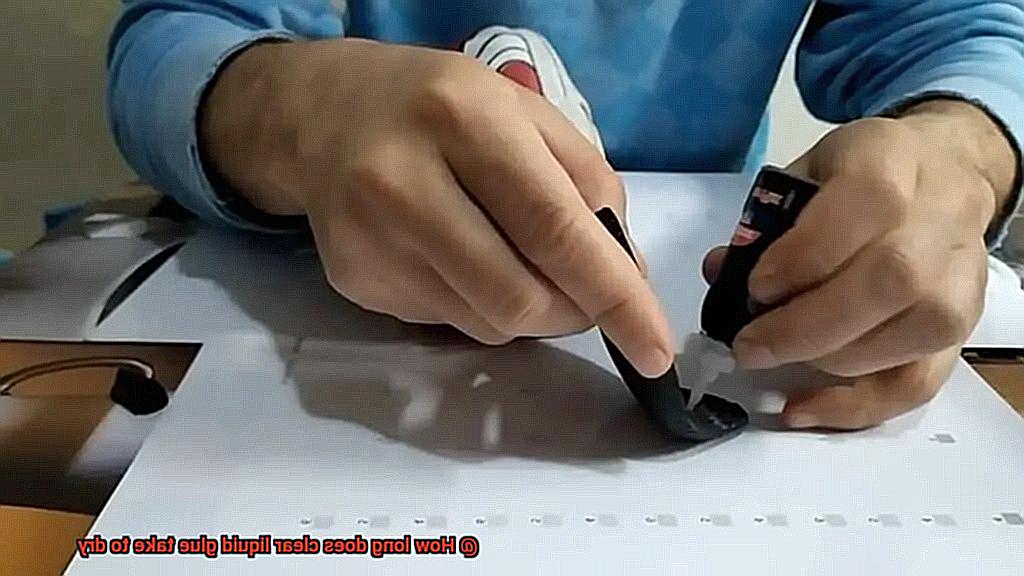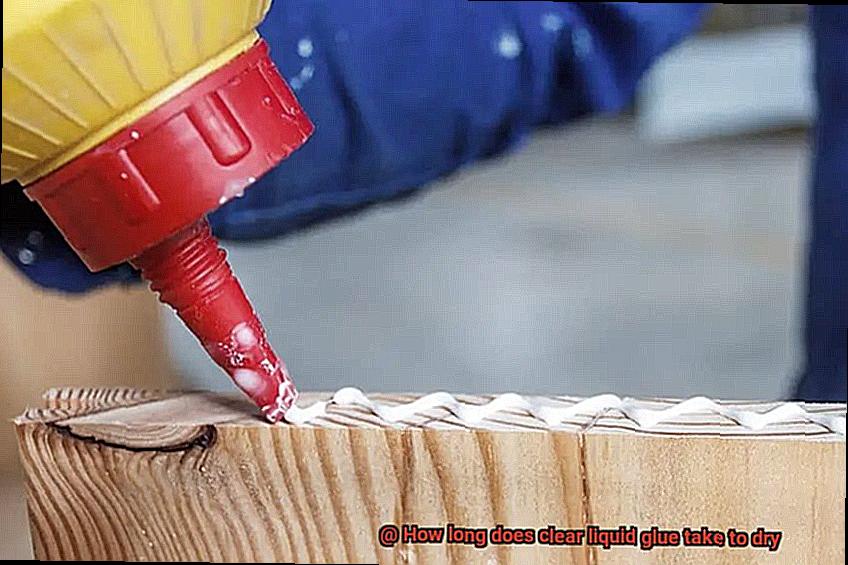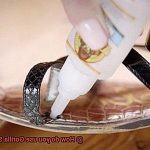We’ve all been there – anxiously waiting for that clear liquid glue to dry so we can finally finish our craft projects or repairs. But let’s face it, figuring out how long it takes for this sticky substance to set can be a test of our patience. There are a bunch of factors at play here, from the glue’s chemistry to external influences, all affecting its drying time.
In this blog post, we’ll dive deep into the nitty-gritty details that determine how fast your clear liquid glue dries. And fear not, because we’ll also share some awesome tips and tricks to speed up the process. Whether you’re a DIY fanatic or just someone in desperate need of quick fixes, understanding the science behind clear liquid glue drying will make your crafting adventures even more exciting.
So grab yourself a refreshing drink, get comfy, and join us as we unravel the captivating world of clear liquid glue drying.
What is Clear Liquid Glue?
Contents
This versatile adhesive, also known as transparent adhesive or clear craft glue, has the power to transform ordinary materials into extraordinary works of art. In this blog post, we’ll dive into the world of clear liquid glue, exploring its uses, benefits, and tips for achieving stunning results.
Versatility is Key:
Clear liquid glue is a true jack-of-all-trades when it comes to bonding materials. Whether you’re working with paper, cardboard, fabric, leather, wood, or even certain plastics, this adhesive is up to the task. Its ability to adhere to various surfaces makes it a go-to choice for a wide range of projects, from scrapbooking and card making to decoupage and repairs around the house.
Invisible Bonding:
One of the most remarkable features of clear liquid glue is its ability to dry transparent. Unlike other adhesives that leave behind visible marks or residue, clear liquid glue becomes virtually invisible once it dries. This makes it perfect for projects where you want the focus to be on the artistic elements rather than the glue itself. Say goodbye to unsightly smudges and hello to seamless creations.
Precision Application:
Clear liquid glue usually comes in a bottle with a narrow nozzle or applicator tip, allowing for precise application. Whether you need to create thin lines, delicate dots, or cover larger areas, this adhesive grants you ultimate control over your project. No more worrying about messy mishaps or glue globs ruining your masterpiece.
Drying Time:
The drying time of clear liquid glue can vary depending on factors such as humidity, temperature, and the thickness of the glue layer. While some glues claim to dry within seconds, others may require more time to fully set and bond. It’s important to follow the manufacturer’s instructions to ensure optimal results. Remember, patience is key when it comes to achieving a strong and durable bond.
Safety Considerations:
While clear liquid glue is generally safe to use, it’s always a good idea to take precautionary measures. Ensure proper ventilation when working with glue to avoid inhaling fumes. Additionally, keep glue away from children and pets, as ingestion can be harmful. If contact with skin or eyes occurs, rinse thoroughly with water and seek medical attention if necessary.
Factors That Affect Drying Time
Understanding the factors that affect its drying time is essential for achieving optimal results. Let’s explore the various factors that influence how quickly clear liquid glue sets and dries.
Firstly, the type of glue used plays a significant role in determining drying time. Different glues have unique formulations and ingredients, which can affect their speed of drying. Some glues are specifically formulated to dry faster, while others may take longer to fully set and dry.
The environment in which the glue is applied also matters. Temperature and humidity have a considerable impact on drying time. Higher temperatures accelerate the process, while cooler temperatures slow it down. Additionally, low humidity levels promote quicker drying, whereas high humidity can prolong the drying time.
The thickness of the glue layer is another crucial factor to consider. Thick layers require more time for the solvent in the glue to completely evaporate, resulting in longer drying times. To expedite the process, opt for thin layers of glue when time is of the essence.
Furthermore, the porosity of the surface being glued affects drying time. Porous surfaces like wood or fabric tend to absorb moisture from the glue, causing delays in drying. Non-porous surfaces like glass or metal allow for faster drying as there is no absorption.
Proper ventilation is essential for efficient drying. Adequate airflow helps carry away moisture and speeds up evaporation. Working in a well-ventilated area or utilizing fans and open windows can significantly expedite the drying process.
The quality and brand of clear liquid glue can also impact drying time. Higher quality glues often have superior formulations designed for faster drying. Conversely, cheaper or lower-quality glues may take longer to dry or not fully set at all.
Finally, some clear liquid glues may contain additives or accelerators that enhance the drying process. These additives are often included to cater to specific applications or provide a faster bonding time. Always refer to the product instructions or labels for recommended additives or accelerators.
Types of Glue and Their Drying Times
Glue is a powerful ally in the world of crafts and repairs, but not all glues are created equal. Each type boasts its own unique properties and drying times, making it crucial to understand the nuances of glue selection. In this article, we will embark on a journey through the realm of glue, discovering the diverse types available and their corresponding drying times.
White Glue – Craftsmanship at its Finest:
White glue, often called school glue or craft glue, is an essential tool in every artist’s repertoire. Composed of a water-based formula, white glue necessitates moisture to dry effectively. Generally, it takes approximately 30 minutes to an hour for white glue to dry completely. However, external factors like temperature and humidity can impact drying time. So, be patient and allow your masterpiece to dry thoroughly.
Wood Glue – Unbreakable Bonds:
When it comes to forging connections between wooden surfaces, wood glue reigns supreme. With superior strength compared to white glue, it ensures durable bonds. Drying times for wood glue vary from 30 minutes to 24 hours, contingent upon the brand and wood type used. To guarantee a steadfast bond, secure the pieces together with clamps during the drying process.
Super Glue – The Hero of Swift Fixes:
Super glue possesses superheroic qualities in terms of rapid repairs. Commonly referred to as cyanoacrylate adhesive, it forms an instant bond. Within seconds to a few minutes, your broken item will be restored to its former glory. However, exercise caution not to inadvertently adhere your fingers together.
Epoxy Resin – The Mighty Bond Builder:
Epoxy resin exhibits remarkable prowess as a two-part adhesive, consisting of a resin and a hardener. When combined, these elements culminate in a robust and enduring bond. Drying times for epoxy resin fluctuate between 24 hours and several days, contingent upon the brand and formulation. To achieve optimal results, meticulously adhere to the instructions provided.
Hot Glue – Craftsmanship at Lightning Speed:
Hot glue, often referred to as hot melt adhesive, holds a special place in the hearts of crafters and DIY enthusiasts alike. It dries swiftly, within seconds to a few minutes, depending on the quantity applied. However, it is advisable to allot additional time for complete solidification and maximum strength.
Fabric Glue – Seamlessly Stitched:
For sewing ventures and fabric repairs, fabric glue emerges as your trusty adhesive companion. Drying times generally encompass 24 hours for fabric glue to dry entirely. To ensure an unyielding bond, adhere strictly to the manufacturer’s instructions.

Humidity, Temperature, and Thickness of Glue Layer
Delving into the intriguing world of glue drying, understanding the interplay between humidity, temperature, and the thickness of the glue layer is essential for achieving optimal results. In this comprehensive exploration, we will uncover the fascinating science behind these factors and how they influence the drying process. So grab your glue gun and let’s embark on this enlightening journey.
Humidity: The Moisture Mambo
Humidity, the amount of moisture saturating the air, wields a significant influence on glue drying. In high humidity conditions, where moisture hangs heavy in the air, clear liquid glue extends its drying time. Excess moisture inhibits water evaporation from the glue, creating a sluggish drying process. Conversely, low humidity conditions with drier air expedite the evaporation process, leading to faster drying.
Temperature: The Heatwave Effect
Temperature acts as a pivotal player in the glue drying symphony. Higher temperatures usher in an accelerated drying process by intensifying water evaporation from the glue. Conversely, lower temperatures impede evaporation, extending drying time. However, extreme temperatures must be approached with caution. Excessive heat may cause the glue to dry too rapidly, resulting in weakened bonds. Extreme cold can also hinder proper drying altogether.
Thickness: The Layered Symphony
The thickness of the glue layer intricately determines drying time. Thicker layers necessitate more time to dry as there is a greater water content that needs to evaporate. Moreover, thicker layers tend to trap air pockets within the glue, further impeding drying. Conversely, thinner layers dry expeditiously due to their lesser water content and fewer air pockets.
Materials Being Glued Together
Get ready to discover the world of clear liquid glue and its captivating dance with different materials. It’s like a magical symphony where humidity, temperature, and the thickness of the glue layer come together to create the perfect bond. So, let’s dive into this enchanting world of drying time.
First, let’s talk about porous materials like paper and cardboard. Clear liquid glue loves to seep into their fibers, creating a bond that’s as strong as steel. The drying time for these materials is usually quick, ranging from a few minutes to an hour.
But beware of factors like humidity and temperature – they can slow down the magic. So, if it’s humid or chilly outside, be patient and give it some extra time to dry.
Now let’s move on to fabrics – your favorite materials for fashion and crafts. Clear liquid glue can work wonders on fabrics, fixing tears and reinforcing seams. The drying time here varies depending on the fabric type and the amount of glue used.
Lightweight fabrics like silk or chiffon may dry within an hour, while thicker ones like denim or canvas might take a few hours to fully dry. Remember, patience is the key to a flawless bond.
Wood takes center stage now – a material that has been used for centuries in construction and art. When gluing wood together, the drying time depends on its porosity and moisture content. If you’re working with dry pieces of wood, expect a drying time of around 30 minutes to a few hours. But if your wood is moist or has high moisture content, it’s best to wait until it’s dry before applying glue. We want that bond to be rock solid.
Plastic materials also get a chance to show their bonding powers with clear liquid glue. Just make sure you choose an adhesive specifically made for plastics. The drying time here can vary greatly based on the type of plastic and adhesive used. Some adhesives formulated for plastics may dry within minutes, while others might take several hours or even overnight to reach their full strength. So, be patient – Rome wasn’t glued in a day.
Last but not least, let’s give a standing ovation to metal bonding. When gluing metals together, it’s essential to use an adhesive designed for this purpose. The drying time for metal bonding can vary depending on the type of metal and adhesive used. Some adhesives may dry within minutes, while others might require a few hours or more to achieve optimal strength. So, take your time and let that bond become as strong as steel.
Curing vs. Drying
Glue, that magical substance that holds our world together, comes in various forms and types. But have you ever wondered about the science behind the setting and hardening of clear liquid glue? In this blog post, we will dive into the fascinating world of curing and drying, two essential processes that occur during the adhesive journey.
Drying: The Dance of Evaporation
When you apply clear liquid glue to a surface, the solvent, typically water-based, starts its mesmerizing dance with the air. As the water evaporates, it leaves behind a thin layer of adhesive material, creating a tackiness that will eventually dry completely. Temperature, humidity, and the thickness of the glue layer all influence drying time. So, be patient and let the enchanting world of drying time work its magic.
Curing: The Molecular Transformation
Once the glue has dried and you think it’s ready for action, hold on. Curing is where the real magic happens. During this process, a chemical reaction occurs within the adhesive, forming strong bonds between molecules and transforming it into a solid state. This molecular transformation enhances the strength and durability of the bond over time. But remember, curing takes longer than drying. So, resist the urge to put stress on your glued objects until they have fully cured.
The Waiting Game: Patience is Key
While drying is relatively quick, curing can take days or even weeks. Factors such as temperature and humidity play a significant role in this waiting game. Higher temperatures can expedite curing, while lower temperatures may slow it down. It’s essential to give your glue ample time to cure to ensure maximum bond strength and durability.
Following Manufacturer’s Instructions
Today, we embark on a journey into the captivating world of clear liquid glue and discover the awe-inspiring power of following the manufacturer’s instructions. Get ready to unlock the secrets behind achieving optimal results and maximizing the effectiveness of this magical adhesive. So, grab your glue guns, and let’s dive in.
Drying Time: Unleashing Glue-tastic Success
Clear liquid glue, like all adhesives, possesses its own unique drying personality. Each brand or type may have a distinct drying time due to its special formulation. These instructions act as your golden ticket to a successful bonding experience.
By adhering to the recommended drying time provided by the manufacturer, you ensure that your glued objects reach their maximum strength and durability.
Creating the Perfect Environment: Where Glue Meets Magic
Did you know that glues can be just as finicky about their surroundings as we are? Indeed, they have preferences too. The manufacturer’s instructions often include recommendations for creating an optimal drying environment.
Some glues might require specific temperature ranges or well-ventilated areas to work their magic. By embracing these guidelines, you provide your glue with a cozy little home to perform its miraculous bonding act, avoiding frustratingly long drying times or incomplete adhesion.
Precautions: A Crafty Wizard’s Guide
Just like a wise wizard, the manufacturer knows best when it comes to handling clear liquid glue. Paying close attention to any precautions or limitations mentioned in the instructions is paramount.
These guidelines may highlight specific materials the glue can be used on or surface preparations required before application. Ignoring these warnings could lead to disastrous outcomes—no one wants weak bonds or damaged materials. Trust in the manufacturer’s wisdom to guide you through the enchanting world of clear liquid glue.
Tapping into Manufacturer’s Expertise
Think of the manufacturer as your personal glue guru. They have poured their expertise and knowledge into creating these instructions, ensuring you get the best out of their glue. By following their recommendations, you tap into a wealth of tested and researched information.
Applying Pressure or Using Clamps
Whether you’re a DIY aficionado, a crafting connoisseur, or simply someone who appreciates the wonders of adhesive magic, prepare to embark on an exciting journey. Today, we will delve into the fascinating world of applying pressure or using clamps when working with clear liquid glue. By understanding and utilizing these techniques effectively, you will acquire valuable insights to elevate your glue-related endeavors.
The Power of Pressure:
When it comes to creating an unyielding bond, applying pressure is a game-changer. By exerting force between the surfaces being glued, pressure ensures maximum contact and enhances the adhesive properties of clear liquid glue. This technique proves particularly useful when dealing with materials that possess irregular surfaces or necessitate additional strength.
Advantages of Pressure:
- Stronger bonds: Applying pressure guarantees a robust and long-lasting bond between the glued surfaces.
- Versatility: Pressure can be applied in various ways, depending on the type of glue and materials involved.
- Speedier drying time: The application of pressure accelerates the drying process, enabling you to progress with your project sooner.
Disadvantages of Pressure:
- Potential damage: Excessive pressure can harm delicate materials or misalign objects being glued together. Caution is necessary to avoid any mishaps.
- Limited accessibility: Applying pressure may prove challenging for certain projects that involve hard-to-reach areas or irregular shapes.
The Marvels of Clamps:
Clamps serve as indispensable tools for gluing larger or heavier objects together. They provide constant and even pressure along the entire surface area, guaranteeing a secure bond capable of withstanding the test of time.
Advantages of Clamps:
- Even distribution of pressure: Clamps distribute pressure uniformly, eradicating any potential weak spots in the bond.
- Enhanced precision: Clamps enable precise positioning, ensuring perfect alignment of the glued surfaces.
- Ideal for challenging projects: Clamps prove particularly beneficial when working with materials that require extended drying times or irregular shapes.

Disadvantages of Clamps:
- Limited availability: Depending on the size and weight of the project, finding suitable clamps may pose a challenge for some DIY enthusiasts.
- Extended drying time: While clamps expedite the bonding process, certain glues may necessitate several hours or even overnight drying to attain optimal strength.
The Perfect Balance:
To achieve the perfect balance between drying time and bond strength, meticulous adherence to the manufacturer’s instructions is crucial. Each glue possesses unique properties and requirements, necessitating a thorough reading of the provided guidelines. Remember, patience is key. Prematurely removing pressure or releasing clamps can compromise the integrity of the bond and lead to failure.
Conclusion
Clear liquid glue typically takes about 15 to 30 minutes to dry completely. However, the drying time can vary depending on factors such as humidity levels, temperature, and the thickness of the glue application. In ideal conditions with moderate humidity and room temperature, the glue may dry faster. Conversely, in high humidity or cold temperatures, the drying process may take longer.
It’s important to note that while the surface of the glue may appear dry within minutes, it is still advisable to allow ample time for complete drying before handling or applying any pressure. This ensures a strong bond and prevents any potential smudging or smearing.
To speed up the drying process, you can use techniques like blowing air with a fan or using a hairdryer on low heat setting from a safe distance. However, exercise caution when using external heat sources as excessive heat can cause warping or damage certain materials.
In conclusion, clear liquid glue generally dries within 15 to 30 minutes but can be influenced by environmental factors.






